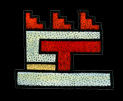Aztec and Maya Calendar
In the tonalpohualli, the sacred Aztec calendar, Tuesday June 26, 1973 is:
Xihuitl:
solar year


13 - Calli (house)
Xiuhpohualli:
365-day calendar
14 - Teotleco (XII)
Long Count:
Mayan calendar
12.17.19.16.17
(Correlation: Alfonso Caso - Nicholson's veintena alignment [adjust])
The significance of this day
Day Ollin (Movement, known as Caban in Maya) is governed by Xolotl as its provider of tonalli (Shadow Soul) life energy. This is an auspicious day for the active principle, a bad day for the passive principle. Ollin is a day of the purified heart, signifying those moments where human beings may perceive what they are becoming. A good day for transmutation, which arrives like an earthquake that leaves in its wake the ruins of rationality, order and the preconceived.
The thirteen day period (trecena) that starts with day 1-Mazatl (Deer) is ruled by Tepeyollotl, the Heart of the Mountain, the Jaguar of Night, lord of the animals and darkened caves. Tepeyollotl is Tezcatlipoca disguised in a jaguar hide, whose voice is the echo in the wilderness and whose word is the darkness itself, calls to the heart in the voice of the conch. These are 13 days associated with the hunt: whether one is the hunter or the game, this trecena reminds us that our lives are determined by the act of stalking. The arts of tracking and back-tracking, of spotting and camouflaging, of following tracks and covering tracks, rule our lives to the degree that we master them. These are good days to study the routines of others; bad days to keep to your routines.
Gretchen Wilson was born on day 11-Ollin.
Aztec facts
The last New Fire ceremony rituals (performed at the end of a 52-year calendar round or xiuhmolpilli) under Aztec reign were probably held from January 23 to February 4, 1507.



